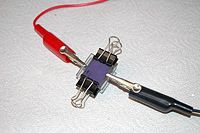K-12 Outreach Introduction
| K-12 Outreach Kits | Next Topic |
Outreach Overview
These kits are being assembled for loan to CMDITR members to enhance their outreach activities. Each kit contains materials for several demonstrations and in some cases hands-on materials that are suitable for various grade levels. There is one kit for one general interest area.
Download complete manuals for 3 kits
As a scientist who is deeply immersed in your research it is easy to overestimate the sophistication and content background of children. Even common events that you might consider everyday students may have not encountered. One of the reason of doing hands-on demos is to give students a shared concrete experience on which to build understanding and connections.
The table below suggests the topics that might be appropriate for each audience. Note: sometimes the materials in a kit might be quite impressive to kids even when the scientific explanation is inappropriate at lower levels. We assume you will be adjusting your presentation to make it fit the audience and venue.
Outreach Kits Topic Matrix
| Kit | Elementary Topics | Middle School / Public Topics | High School Topics |
|---|---|---|---|
| Basic Optics - Outreach Kit | Light goes straight, Color mixing | Lenses, optics, refraction, reflection, absorption | Polarization, Diffraction, emission spectra, dye sensitized solar cell |
| Photovoltaics- Outreach Kit | Solar car, Batteries | Angle /area dependence, Types of PV cells | Total efficiency, measuring VC curves, color absorption |
| Lasers and Telecommunication- Outreach Kit | Optical fiber, water stream demo, | Total internal reflection, Tyndal effect | Polarization, Interferometer, Index of refraction, optical networks |
| Nanocrystalline - Dye Solar Cell Kit | Total efficiency, measuring VC curves, color absorption, oxidation-reduction, |
The Kits
- Basic Optics - Outreach Kit
- Lasers and Telecommunication- Outreach Kit
- Photovoltaics- Outreach Kit
- Nanocrystalline - Dye Solar Cell Kit
Assembling the Kits
To build your own kits start by ordering the components listed at the end of the wiki for each kit. Most of the materials in the original kits are provided in quantities for a table top demo (1-2 copies). If you know that you are going to want to do a larger group where everyone needs a polarizing filter for example then order enough for a class. Be warned that that if you pass out something cool to everyone in a class you are probably not going to get them all back!
- Print the manual with a color printer and assemble with a 1 1/2" three ring binder with separators for each activity.
- Place materials for each activity in three ring, zip lock binder bags so they are organized with each activity. You may want to keep the additional product info and lessons that come with each component at the end of the binder.
- Keep all the materials and binder in a plastic snap case from Storables. The box needs to be 17"x13"x6".
Storables- Large Snap Case $7.95
Education Standards
Science classroom time is packed full and teachers have many specific educational objective that are dictated by their districts and states. One key to being welcomed to the classroom is to relate your presentation to specific content they have to cover anyway. Even if your specific science is not covered you can switch the activity format to address general process skills such as observation, hypothesing, designing an experiment and interpreting results. Careers and the connect between science, technology and society are also hooks that tie into must curricula.
To learn what is taught at various grade levels check the National Science Education Standards, AAAS Project 2061 and the links to state Science below.
National Science Education Standards - Grade level Content
AAAS 2061 Benchmarks - The Physical Setting
Education World State Standards Links
National Science Teachers Association- Science Scope and Coordination
More Hands On Demos and Activity Ideas
HANDS ON OPTICS- (from OSA, SPIE and NOA0
APS Project Sol- Animation explains silicon solar solar cells
Solar Cell Kit-How to build your own solar cell
Innovative Methods to Teach Optics in the Grade 5- (including jello optics)
Institute for Chemical Education- Source for kits
Video labs in Nanotechnology from Univ. Wisconsin MRSEC
Rochester Optics demonstrations for Eday
OSA classroom materials including the Optics Suitcase
Lab Interfacing
Using a computer to connect to measurement probes is very common in research. In demonstrations it gives you the chance to generated a data display on the fly while you are doing a demo to get students more engaged. Voltage, current, light and temperature probes are available and there are simple analog to digital converters that can plug into your USB interface.
Audacity Oscilloscope using sound card
Experimental Flash Voltmeter using microphone input- .5 volts or less
Resources for Informal Science Education
Informal Science Education - Good resource to see what museums are doing with outreach activities.
